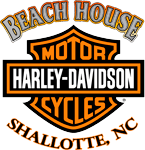Beginner's Trike Riding Tips
The addition of an extra wheel is more significant than you might think when it comes to how a three-wheeled motorcycle handles. Even experienced bikers might be thrown by the differences in how the vehicle handles. Luckily, trikes are overall easy to learn to ride, and once you get some practice in you should have no trouble. Follow these tips from Beach House Harley-Davidson® to get started learning how to ride a three-wheeled motorcycle.
Starting the Trike
Before you try to get anywhere, you have to know the proper way to start the trike. First, engage the brakes and clutch. Once you have shifted into first gear, you can release the brakes. As you increase the throttle, release the clutch as well.
Shifting Gears
Next, you need to learn how to shift gears. If you have experience operating a manual transmission car, the process is very similar. Start by dropping the throttle and engaging the clutch. You can then shift to the desired gear. Once you’ve shifted gears completely, you are free to let the clutch out. It is very easy to lose control of the trike while shifting gears, so always be careful when performing the shift. If possible try to only shift while driving in a straight line, as this will make the process easier. If you suffer a stalled engine or the trike jerks forward, you are not shifting correctly.
Turning On A Bike VS A Trike
On a two-wheeled motorcycle, the rider steers by leaning to counter centrifugal forces, a technique called "countersteering". By using this technique, the rider can turn without tipping over. This is in contrast to three-wheeled motorcycles, which use “direct steering”. Much like an ATV, trike riders turn their vehicles by tilting the handlebars. This means that steering a trike is easier than steering a traditional motorcycle.
Turning On A Trike
When you are operating a trike and you see an upcoming turn, slow down to make the turn easier. As you approach the turn itself, maintain speed and turn the handlebars in the appropriate direction. Do not hit the throttle again until you exit the corner. Jerky turns can cause you to lose control of the vehicle, so focus on executing the turn as smoothly as possible. You should also remember that a trike is much wider than a two-wheeled motorcycle, meaning the angle you take the turn will be different. If you take a corner too sharply, you can end up with one of your wheels coming off the ground!
Stopping on a Trike
Three-wheeled motorcycles are bigger and heavier than their traditional counterparts. The additional weight makes it harder to stop easily, so make sure that you are giving yourself plenty of stopping distance. Avoid hard braking, as this can cause the brakes to lock up and you to lose control of the vehicle.
Most trike models have separate braking systems for the front wheel(s) and the back wheel(s). If you choose to engage only one of these systems, always go with the back wheel brakes to avoid being thrown for the trike. If you need more braking power, you can engage both systems at the same time.
Practice, Practice, Practice
Mastery doesn’t come overnight. Before you hit the open road, practice these basic maneuvers in a vacant lot or another safe area where the chances of accidentally hitting someone else are very low. Over time, operating your trike will become easier, and you will be able to go just about anywhere you like.
If you are ready to view our selection of new and pre-owned trike models, visit Beach House Harley-Davidson® at our dealership in Shallotte, North Carolina. We also offer various services like riding classes, parts ordering, servicing, and financing, visit us for all your motorcycle-related needs. We are proud to be your local Harley dealer for Brunswick County, North Carolina, and we hope to see you soon!
